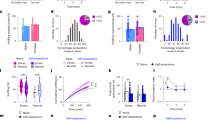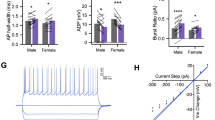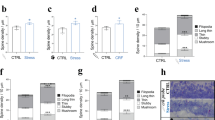Abstract
Variations in individual coping styles have been linked to either resilience or vulnerability towards stress, thereby influencing the probability of developing stress-related disorders. The involvement of corticotropin-releasing factor (CRF) neurons within the medial prefrontal cortex (mPFC) plays a crucial role in modulating behavioral responses to stressful situations. In this study utilizing a mouse model of social defeat stress (SDS), we demonstrate how coordinated activation and localized release of CRF within the mPFC contribute to promoting adaptive responses under stressful conditions leading to enhanced resilience against subsequent challenges. Specifically, during SDS exposure, heightened activity levels were observed among mPFC CRF neurons coincide with increased local release triggered by active exploration and defensive behaviors, while decreased responses were detected upon exposure to aggression. Interestingly, the CRF neural activity and local release responding to coping behaviors throughout chronic social defeat stress (CSDS) differed between susceptible and resilient mice. Furthermore, activation of CRF receptor 1 (CRFR1) signaling in the mPFC enhanced active coping behaviors and conferred resilience to CSDS, while inhibition of CRF system promoted passive coping behaviors and induced susceptibility to sub-threshold SDS. Additionally, inhibition of CRFR1 in the mPFC nullified the pro-resilience effect elicited by activation of CRF neurons during CSDS. The collective findings provide evidence supporting the crucial role of local endogenous CRF derived from mPFC CRF neurons in maintaining resilience through active coping styles when confronted with social stress. Moreover, these results suggest that targeting the mPFC CRF system could hold promise as a therapeutic approach for managing stress-related disorders.
This is a preview of subscription content, access via your institution
Access options
Subscribe to this journal
Receive 13 print issues and online access
269,00 € per year
only 20,69 € per issue
Buy this article
- Purchase on SpringerLink
- Instant access to full article PDF
Prices may be subject to local taxes which are calculated during checkout





Similar content being viewed by others
Data availability
The data that support the findings of this study are available from the corresponding authors upon reasonable request.
References
Akil H, Nestler EJ. The neurobiology of stress: vulnerability, resilience, and major depression. Proc Natl Acad Sci USA. 2023;120:e2312662120.
Lucassen PJ, Pruessner J, Sousa N, Almeida OFX, Van Dam AM, Rajkowska G, et al. Neuropathology of stress. Acta Neuropathol. 2014;127:109–35.
Chrousos GP. Stress and disorders of the stress system. Nat Rev Endocrinol. 2009;5:374–81.
de Kloet ER, Joëls M, Holsboer F. Stress and the brain: from adaptation to disease. Nat Rev Neurosci. 2005;6:463–75.
Wood SK, Bhatnagar S. Resilience to the effects of social stress: evidence from clinical and preclinical studies on the role of coping strategies. Neurobiol Stress. 2015;1:164–73.
Puglisi-Allegra S, Andolina D. Serotonin and stress coping. Behav Brain Res. 2015;277:58–67.
Koolhaas JM, Korte SM, De Boer SF, Van Der Vegt BJ, Van Reenen CG, Hopster H, et al. Coping styles in animals: current status in behavior and stress-physiology. Neurosci Biobehav Rev. 1999;23:925–35.
Han MH, Nestler EJ. Neural substrates of depression and resilience. Neurotherapeutics. 2017;14:677–86.
Bhatnagar S. Rethinking stress resilience. Trends Neurosci. 2021;44:936–45.
Cathomas F, Murrough JW, Nestler EJ, Han M-H, Russo SJ. Neurobiology of resilience: interface between mind and body. Biol Psychiatry. 2019;86:410–20.
Li HY, Zhu MZ, Yuan XR, Guo ZX, Pan YD, Li YQ, et al. A thalamic-primary auditory cortex circuit mediates resilience to stress. Cell. 2023;186:1352–68.e18.
Zhukovskaya A, Zimmerman CA, Willmore L, Pan-Vazquez A, Janarthanan SR, Lynch LA, et al. Heightened lateral habenula activity during stress produces brainwide and behavioral substrates of susceptibility. Neuron. 2024;112:3940–3956.
Escobedo A, Holloway SA, Votoupal M, Cone AL, Skelton H, Legaria AA, et al. Glutamatergic supramammillary nucleus neurons respond to threatening stressors and promote active coping. Elife. 2024;12:RP90972.
Deussing JM, Chen A. The corticotropin-releasing factor family: physiology of the stress response. Physiol Rev. 2018;98:2225–86.
Russell G, Lightman S. The human stress response. Nat Rev Endocrinol. 2019;15:525–34.
Rasiah NP, Loewen SP, Bains JS. Windows into stress: a glimpse at emerging roles for CRHPVN neurons. Physiol Rev. 2023;103:1667–91.
Wang Y, Hu P, Shan QH, Huang CA, Huang ZH, Chen P, et al. Single-cell morphological characterization of CRH neurons throughout the whole mouse brain. BMC Biol. 2021;19:47.
Hu P, Wang Y, Qi XH, Shan QH, Huang ZH, Chen P, et al. SIRT1 in the BNST modulates chronic stress-induced anxiety of male mice via FKBP5 and corticotropin-releasing factor signaling. Mol Psychiatry. 2023;28:5101–17.
Xu XL, Zheng SD, Ren JY, Li ZX, Li JY, Xu ZB, et al. Hypothalamic CRF neurons facilitate brain reward function. Curr Biol. 2024;34:389–402.e5.
Zhang N, Zhao S, Ma Y, Xiao Z, Xue B, Dong Y, et al. Hyperexcitation of ovBNST CRF neurons during stress contributes to female-biased expression of anxiety-like avoidance behaviors. Sci Adv. 2024;10:eadk7636.
Füzesi T, Rasiah NP, Rosenegger DG, Rojas-Carvajal M, Chomiak T, Daviu N, et al. Hypothalamic CRH neurons represent physiological memory of positive and negative experience. Nat Commun. 2023;14:8522.
Birnie MT, Short AK, de Carvalho GB, Taniguchi L, Gunn BG, Pham AL, et al. Stress-induced plasticity of a CRH/GABA projection disrupts reward behaviors in mice. Nat Commun. 2023;14:1088.
Kim J, Lee S, Fang YY, Shin A, Park S, Hashikawa K, et al. Rapid, biphasic CRF neuronal responses encode positive and negative valence. Nat Neurosci. 2019;22:576–85.
Lv Y, Chen P, Shan QH, Qin XY, Qi XH, Zhou JN. Regulation of cued fear expression via corticotropin-releasing-factor neurons in the ventral anteromedial thalamic nucleus. Neurosci Bull. 2021;37:217–28.
Li SY, Cao JJ, Tan K, Fan L, Wang YQ, Shen ZX, et al. CRH neurons in the lateral hypothalamic area regulate feeding behavior of mice. Curr Biol. 2023;33:4827–43 e7.
Wang T, Ma Y-N, Zhang C-C, Liu X, Sun Y-X, Wang H-L, et al. The nucleus accumbens CRH-CRHR1 system mediates early-life stress-induced sleep disturbance and dendritic atrophy in the adult mouse. Neuroscience Bulletin. 2023;39:41–56.
Shinohara R, Furuyashiki T. Prefrontal contributions to mental resilience: lessons from rodent studies of stress and antidepressant actions. Neurosci Res. 2025;211:16–23.
Warden MR, Selimbeyoglu A, Mirzabekov JJ, Lo M, Thompson KR, Kim S-Y, et al. A prefrontal cortex-brainstem neuronal projection that controls response to behavioural challenge. Nature. 2012;492:428–32.
Kumar S, Hultman R, Hughes D, Michel N, Katz BM, Dzirasa K. Prefrontal cortex reactivity underlies trait vulnerability to chronic social defeat stress. Nat Commun. 2014;5:4537.
Franklin TB, Silva BA, Perova Z, Marrone L, Masferrer ME, Zhan Y, et al. Prefrontal cortical control of a brainstem social behavior circuit. Nat Neurosci. 2017;20:260–70.
Chen P, Lou S, Huang ZH, Wang Z, Shan QH, Wang Y, et al. Prefrontal cortex corticotropin-releasing factor neurons control behavioral style selection under challenging situations. Neuron. 2020;106:301–15.e7.
Uribe-Mariño A, Gassen NC, Wiesbeck MF, Balsevich G, Santarelli S, Solfrank B, et al. Prefrontal cortex corticotropin-releasing factor receptor 1 conveys acute stress-induced executive dysfunction. Biol Psychiatry. 2016;80:743–53.
Lv SS, Lv XJ, Cai YQ, Hou XY, Zhang ZZ, Wang GH, et al. Corticotropin-releasing hormone neurons control trigeminal neuralgia-induced anxiodepression via a hippocampus-to-prefrontal circuit. Sci Adv. 2024;10:eadj4196.
Riad MH, Park K, Ibañez-Tallon I, Heintz N. Local production of corticotropin-releasing hormone in prefrontal cortex modulates male-specific novelty exploration. Proc Natl Acad Sci USA. 2022;119:e2211454119.
Ohata H, Shibasaki T. Microinjection of different doses of corticotropin-releasing factor into the medial prefrontal cortex produces effects opposing anxiety-related behavior in rats. J Nippon Med School. 2011;78:286–92.
Śmiałowska M, Zięba B, Domin H. A role of noradrenergic receptors in anxiolytic-like effect of high CRF in the rat frontal cortex. Neuropeptides. 2021;88:102162.
Zieba B, Grzegorzewska M, Brański P, Domin H, Wierońska JM, Hess G, et al. The behavioural and electrophysiological effects of CRF in rat frontal cortex. Neuropeptides. 2008;42:513–23.
de León Reyes NS, Sierra Díaz P, Nogueira R, Ruiz-Pino A, Nomura Y, de Solis CA, et al. Corticotropin-releasing hormone signaling from prefrontal cortex to lateral septum suppresses interaction with familiar mice. Cell. 2023;186::4152–4171.e31.
Li L-F, Zhang L-Z, He Z-X, Yuan W, Ma H, Xun Y-F, et al. CRF-CRFR1 system within the dorsal medial prefrontal cortex are involved in consolation deficits under acute restraint stress in mandarin voles. Psychoneuroendocrinology. 2021;132:105353.
Hupalo S, Martin AJ, Green RK, Devilbiss DM, Berridge CW. Prefrontal corticotropin-releasing factor (CRF) neurons act locally to modulate frontostriatal cognition and circuit function. J Neurosci. 2019;39:2080–90.
Wang H, Qian T, Zhao Y, Zhuo Y, Wu C, Osakada T, et al. A tool kit of highly selective and sensitive genetically encoded neuropeptide sensors. Science. 2023;382:eabq8173.
Golden SA, Covington HE 3rd, Berton O, Russo SJ. A standardized protocol for repeated social defeat stress in mice. Nat Protoc. 2011;6:1183–91.
Krishnan V, Han MH, Graham DL, Berton O, Renthal W, Russo SJ, et al. Molecular adaptations underlying susceptibility and resistance to social defeat in brain reward regions. Cell. 2007;131:391–404.
Kim D-I, Park S, Park S, Ye M, Chen JY, Kang SJ, et al. Presynaptic sensor and silencer of peptidergic transmission reveal neuropeptides as primary transmitters in pontine fear circuit. Cell. 2024;187:5102–5117.e16.
Chaudhury D, Walsh JJ, Friedman AK, Juarez B, Ku SM, Koo JW, et al. Rapid regulation of depression-related behaviours by control of midbrain dopamine neurons. Nature. 2013;493:532–6.
Maier SF, Watkins LR. Role of the medial prefrontal cortex in coping and resilience. Brain Res. 2010;1355:52–60.
Radley JJ, Herman JP. Preclinical models of chronic stress: adaptation or pathology? Biol Psychiatry. 2023;94:194–202.
Southwick SM, Vythilingam M, Charney DS. The psychobiology of depression and resilience to stress: implications for prevention and treatment. Annu Rev Clin Psychol. 2005;1:255–91.
Folkman S, Lazarus RS. An analysis of coping in a middle-aged community sample. J Health Soc Behav. 1980;21:219–39.
Billings AG, Moos RH. Coping, stress, and social resources among adults with unipolar depression. J Pers Soc Psychol. 1984;46:877–91.
Hammels C, Pishva E, De Vry J, van den Hove DL, Prickaerts J, van Winkel R, et al. Defeat stress in rodents: from behavior to molecules. Neurosci Biobehav Rev. 2015;59:111–40.
Wood SK, Walker HE, Valentino RJ, Bhatnagar S. Individual differences in reactivity to social stress predict susceptibility and resilience to a depressive phenotype: role of corticotropin-releasing factor. Endocrinology. 2010;151:1795–805.
Chen RJ, Kelly G, Sengupta A, Heydendael W, Nicholas B, Beltrami S, et al. MicroRNAs as biomarkers of resilience or vulnerability to stress. Neuroscience. 2015;305:36–48.
Grafe LA, Eacret D, Dobkin J, Bhatnagar S. Reduced orexin system function contributes to resilience to repeated social stress. eNeuro. 2018;5:ENEURO.0273-17.2018.
Diaz V, Lin D. Neural circuits for coping with social defeat. Curr Opin Neurobiol. 2020;60:99–107.
Willmore L, Cameron C, Yang J, Witten IB, Falkner AL. Behavioural and dopaminergic signatures of resilience. Nature. 2022;611:124–32.
Murra D, Hilde KL, Fitzpatrick A, Maras PM, Watson SJ, Akil H. Characterizing the behavioral and neuroendocrine features of susceptibility and resilience to social stress. Neurobiol Stress. 2022;17:100437.
Meng QY, Chen XN, Tong DL, Zhou JN. Stress and glucocorticoids regulated corticotropin releasing factor in rat prefrontal cortex. Mol Cell Endocrinol. 2011;342:54–63.
Oh H, Newton D, Lewis D, Sibille E. Lower levels of GABAergic function markers in corticotropin-releasing hormone-expressing neurons in the sgACC of human subjects with depression. Front Psychiatry. 2022;13:827972.
Soumier A, Sibille E. Opposing effects of acute versus chronic blockade of frontal cortex somatostatin-positive inhibitory neurons on behavioral emotionality in mice. Neuropsychopharmacology. 2014;39:2252–62.
Zhao P, Zhao M, Wang H, Jiang T, Jia X, Tian J, et al. Long-range inputome of cortical neurons containing corticotropin-releasing hormone. Sci Rep. 2020;10:12209.
Acknowledgements
We thank Prof. Yu Long Li and Dr. Huan Wang (Peking University) for providing CRF sensor; Prof. Ji Liu (University of Science and Technology of China) for providing Crhr1-Cre and Crhr1flox/flox mice; Rui-Hua Li, Sen-Miao Fang and Jin-Kun Guo (Institute of Brain Science, the First Affiliated Hospital of Anhui Medical University) for help with the experiment.
Funding
This work was supported by the National Natural Science Foundation of China (Grant No. 82471540; 32030046; 32200798; 82201671), Anhui Provincial Natural Science Foundation (2408085Y043).
Author information
Authors and Affiliations
Contributions
J-NZ and PC designed the research; Y-TW and YL performed most of the experiment and statistical analysis and wrote the draft manuscript; M-YL and YW preformed behavioral experiments and statistical analysis; Y-MZ and Q-QX contributed to electrophysiology in vitro; R-YL provided the reagents and helpful suggestions to the manuscript; Q-HS, X-YQ and YW modified the manuscript; J-NZ and PC supervised all aspects of the project and conducted a critical revision of the manuscript. All authors read and approved the final manuscript.
Corresponding authors
Ethics declarations
Competing interests
The authors declare no competing interests.
Additional information
Publisher’s note Springer Nature remains neutral with regard to jurisdictional claims in published maps and institutional affiliations.
Supplementary information
Rights and permissions
Springer Nature or its licensor (e.g. a society or other partner) holds exclusive rights to this article under a publishing agreement with the author(s) or other rightsholder(s); author self-archiving of the accepted manuscript version of this article is solely governed by the terms of such publishing agreement and applicable law.
About this article
Cite this article
Wang, YT., Li, Y., Li, MY. et al. Prefrontal corticotropin-releasing factor promotes resilience to social stress. Neuropsychopharmacol. (2025). https://doi.org/10.1038/s41386-025-02148-6
Received:
Revised:
Accepted:
Published:
DOI: https://doi.org/10.1038/s41386-025-02148-6



